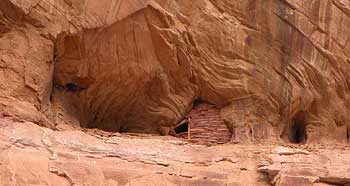Calf Creek Indians
The beautiful Calf Creek canyons were once inhabited by ancient American Indians. Today their presence and influence still remain in the form of ancient dwellings, storage structures (graineries), and hugh life size pictographs. The 5.5 mile round trip trail from the Calf Creek parking lot to the falls gives a glympse of what life might have been like for these Indians.
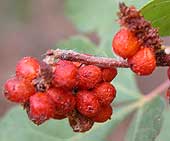 |
| Squawbush. |
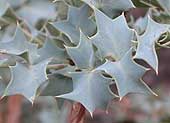 |
| Fremont Barberry. |
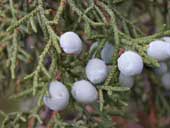 |
| Utah Juniper. |
Many of the plants and trees were used by the Indians such as:
- Four-winged saltbrush (Atriplex
canescens) can be identified by its seeds which have four parts, or wings.
Wildlife and livestock browse this plant.
Native peoples ground and cooked its seeds as a cereal; the leaves
were dried and mixed with other ingredients for flour. Ashes of burned saltbush
were used as a leavening for breads.
- Squawbush (Rhus trilobata) was highly sought after by the early Native Americans.
They ate the red berries and used the pliable brances for making baskets. Due
to its pungent aroma, this plant is sometimes called skunkbush.
- Rabbitbrush (Chrysothamnus nauseosus) was used to make dyes: yellow
from the flowers and green from the inner bark. The inner bark also contains latex
which can be used to make rubber products, but it has not proven practical as a
commercial source of rubber.
- Fremont barberry or hollygrape
(Berberis fremontii) has a leaf like a
holly and a fruit like a grape. A yellow dye can be made from the root extracts.
- One of the prevalent trees at Calf Creek is the Juniper (Juniperus osteosperma).
Commonly called "cedars", junipers are used locally for fence posts.
The seeds ("berries") are eaten by wildlife and dried seeds were used by Native
Americans for making jewelry.
- The pinyon pine (Pinus edulis) tree produces an edible nut long used as a staple food by the Indians. The nuts are an important food source for rodents and birds. Resin from these trees was also used by Indians to waterproof baskets and to cement turquoise stones to jewelry.
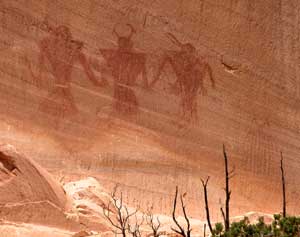 Part way up the trail, these pictographs can be seen located near the bottom of the
eastern wall of Calf Creek canyon. The four large figures are painted in red and
are typical of Fremont style and form. The pictographs date to 1000 A.D. or earlier
and could represent deities, cultural heros, or they may depict a ceremony or event.
Part way up the trail, these pictographs can be seen located near the bottom of the
eastern wall of Calf Creek canyon. The four large figures are painted in red and
are typical of Fremont style and form. The pictographs date to 1000 A.D. or earlier
and could represent deities, cultural heros, or they may depict a ceremony or event.
The following shows another storage structure that can be found along the road
just outside Escalante. The Fremont culture used these as granaries sometime
between 1050 to 1200 A.D. The Fremont were a hunting and gathering soiety who
supplemented that way of life by growing corn, beans, and squash.
